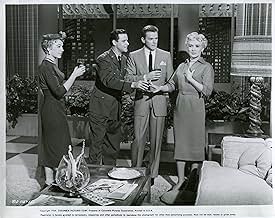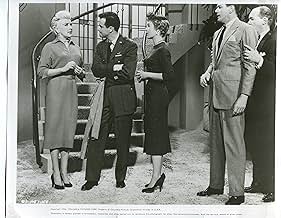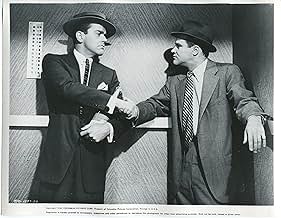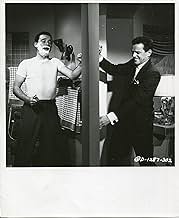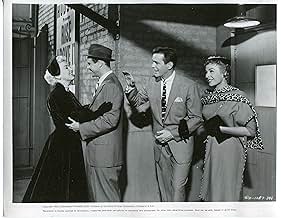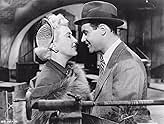CALIFICACIÓN DE IMDb
6.1/10
513
TU CALIFICACIÓN
Una cantante viuda se casa con el compañero de composición de su difunto esposo, lo que causa problemas cuando su primer marido aparece muy vivo.Una cantante viuda se casa con el compañero de composición de su difunto esposo, lo que causa problemas cuando su primer marido aparece muy vivo.Una cantante viuda se casa con el compañero de composición de su difunto esposo, lo que causa problemas cuando su primer marido aparece muy vivo.
- Dirección
- Guionistas
- Elenco
David Ahdar
- Male Harem Dancer
- (sin créditos)
Leon Alton
- Stage Manager
- (sin créditos)
Tom Anthony
- Bit Role
- (sin créditos)
Robert Bice
- Sgt. Charlie O'Hallihan
- (sin créditos)
Bill Boes
- Male Harem Dancer
- (sin créditos)
Eugene Borden
- Costume Designer
- (sin créditos)
Johnny Brazil
- Male Harem Dancer
- (sin créditos)
Eddie Brown
- Male Harem Dancer
- (sin créditos)
George Bruggeman
- Male Harem Dancer
- (sin créditos)
Aileen Carlyle
- Mother
- (sin créditos)
Beulah Christian
- Wardrobe Woman
- (sin créditos)
Gene Dailey
- Male Harem Dancer
- (sin créditos)
John David
- Male Harem Dancer
- (sin créditos)
- Dirección
- Guionistas
- Todo el elenco y el equipo
- Producción, taquilla y más en IMDbPro
Opiniones destacadas
What an interesting pedigree Three For The Show had, dating all the way back to 1920 when W. Somerset Maugham's play Too Many Husbands debuted on Broadway with a long forgotten cast. It had a military background instead of a show business one, though the military does figure prominently in the plot.
Collaborators Jack Lemmon and Gower Champion have a hit show on Broadway for producer Myron McCormick that stars Betty Grable. Lemmon goes into the Air Force during the Korean War and goes MIA. He's reported killed and Grable who was married to Lemmon, now marries Champion. Then of course Lemmon returns and they've a situation the reverse of My Favorite Wife.
In the meantime poor Marge Champion is champing at the bit because she's got a thing for Gower. I think you can figure out where this one is going.
The numbers come from a variety of sources, some original, some Broadway, some classical. Betty Grable in what proved to be her next to last film did more serious type dancing here than in any other. But next to the Champions, she really did not look that good. It was unfair to cast her with them.
Grable also did not like working for Harry Cohn, she was used to another imperious studio mogul over at 20th Century Fox who had kind of eased her out of her number one spot for the fast rising Marilyn Monroe. But she thought he was a pussycat next to Cohn. Two For The Show was Betty's first outside film after 14 year at Fox.
Jack Lemmon proved to have a couple of good singing notes as he does accompany the rest on a number or two. He liked working with Grable because he felt she was unpretentious with a good sense of humor as apparently a lot of her colleagues did.
As a film though, Three For The Show will never rank first rate in the work of either Lemmon or Grable.
Collaborators Jack Lemmon and Gower Champion have a hit show on Broadway for producer Myron McCormick that stars Betty Grable. Lemmon goes into the Air Force during the Korean War and goes MIA. He's reported killed and Grable who was married to Lemmon, now marries Champion. Then of course Lemmon returns and they've a situation the reverse of My Favorite Wife.
In the meantime poor Marge Champion is champing at the bit because she's got a thing for Gower. I think you can figure out where this one is going.
The numbers come from a variety of sources, some original, some Broadway, some classical. Betty Grable in what proved to be her next to last film did more serious type dancing here than in any other. But next to the Champions, she really did not look that good. It was unfair to cast her with them.
Grable also did not like working for Harry Cohn, she was used to another imperious studio mogul over at 20th Century Fox who had kind of eased her out of her number one spot for the fast rising Marilyn Monroe. But she thought he was a pussycat next to Cohn. Two For The Show was Betty's first outside film after 14 year at Fox.
Jack Lemmon proved to have a couple of good singing notes as he does accompany the rest on a number or two. He liked working with Grable because he felt she was unpretentious with a good sense of humor as apparently a lot of her colleagues did.
As a film though, Three For The Show will never rank first rate in the work of either Lemmon or Grable.
It was only a matter of time before a movie musical would be made with an "Enoch Arden" plot. This 1955 Columbia musical was it. Although the film writing credits list a W. Somerset Maugham play, that play itself was a version of the 1864 poem, "Enoch Arden," by Alfred Lord Tennyson. If not an exact take-off, the play was surely inspired by Tennyson's poem, which Maugham would certain have read and known as a British citizen.
The only similarity with Maugham's "Home and Beauty" (written in 1915 and staged in 1919), is that the male character had been reported missing in action (MIA) in the Korean War (then called a conflict). And, there is a short sequence when the two males connive and turn their backs on the woman. Otherwise, "Three for the Show" clearly is a modern comedy musical rendition of the "Enoch Arden" story. And it is most obviously inspired by the 1940 comedy-romance movies that were made, more than anything else.
So, anyway, this is a very good film. Although the story seems a little hokier in this modern setting of the Broadway stage. The two male friends were a writing team that had written a number of successful plays. But, when Marty Stewart is listed as missing by the War Department during the Korean War, wife Gwen Howard after a couple years marries Vernon Lowndes who had been Hudson's partner. Jack Lemmon as Stewart and Betty Grable as Julie Lowndes, provide much of the comedy.
But this film has a tremendous value beyond the comedy and the plot. That is its musical parts, especially the dance numbers and routines. Marge and Gower Champion had danced in several films that showed their talents in one or two numbers. But those supporting roles could hardly begin to show the range and beauty of their dancing. This film does that. It's their best and a wonderfully entertaining musical that showcases great dancing. I think that this single film of the Champions rates with the many outstanding dance musicals of Fred Astaire and Gene Kelly. For that reason alone, this is a real keeper.
On a production note, "Three for the Show" was made by Columbia Pictures. Musicals were still somewhat popular in 1955, though beginning to fade in numbers. Since its founding in 1918, Columbia had reached the second tier of movie studies, right under the big five during Hollywood's golden era (MGM, Warner Brothers, 20th Century Fox, RKO and United Artists). But by the 1950s, Columbia had moved up and was then one of the Big Six, along with Universal - with those two studios replacing UA. By the end of the 20th century, with the demise of MGM and RKO, Disney had grown to be the largest movie company, with Columbia and Universal close behind. Warner Brothers and Fox rounded out the Big Five into the early 21st century.
The only similarity with Maugham's "Home and Beauty" (written in 1915 and staged in 1919), is that the male character had been reported missing in action (MIA) in the Korean War (then called a conflict). And, there is a short sequence when the two males connive and turn their backs on the woman. Otherwise, "Three for the Show" clearly is a modern comedy musical rendition of the "Enoch Arden" story. And it is most obviously inspired by the 1940 comedy-romance movies that were made, more than anything else.
So, anyway, this is a very good film. Although the story seems a little hokier in this modern setting of the Broadway stage. The two male friends were a writing team that had written a number of successful plays. But, when Marty Stewart is listed as missing by the War Department during the Korean War, wife Gwen Howard after a couple years marries Vernon Lowndes who had been Hudson's partner. Jack Lemmon as Stewart and Betty Grable as Julie Lowndes, provide much of the comedy.
But this film has a tremendous value beyond the comedy and the plot. That is its musical parts, especially the dance numbers and routines. Marge and Gower Champion had danced in several films that showed their talents in one or two numbers. But those supporting roles could hardly begin to show the range and beauty of their dancing. This film does that. It's their best and a wonderfully entertaining musical that showcases great dancing. I think that this single film of the Champions rates with the many outstanding dance musicals of Fred Astaire and Gene Kelly. For that reason alone, this is a real keeper.
On a production note, "Three for the Show" was made by Columbia Pictures. Musicals were still somewhat popular in 1955, though beginning to fade in numbers. Since its founding in 1918, Columbia had reached the second tier of movie studies, right under the big five during Hollywood's golden era (MGM, Warner Brothers, 20th Century Fox, RKO and United Artists). But by the 1950s, Columbia had moved up and was then one of the Big Six, along with Universal - with those two studios replacing UA. By the end of the 20th century, with the demise of MGM and RKO, Disney had grown to be the largest movie company, with Columbia and Universal close behind. Warner Brothers and Fox rounded out the Big Five into the early 21st century.
Much has been said to deride this film, it's stars, it's musical format and general premise but I enjoy it
from start to finish. Another musical (from Britain) also released in the mid-fifties ; "Let's Be Happy"
was equally dismissed by critics and public and both films are remembered by devotees only. It's a pity
that both of these musicals brought to a cruel halt the film careers of Betty Grable and Vera-Ellen
respectively ; two of filmdom's brightest and loveliest ladies still in their prime.
The above mentioned musicals are two of my favourites and how overjoyed I am that they have both been preserved on DVD in wide-screen and glorious colour. I'm one very satisfied customer.
The above mentioned musicals are two of my favourites and how overjoyed I am that they have both been preserved on DVD in wide-screen and glorious colour. I'm one very satisfied customer.
Betty grable was 39 when she made Three For The Show, She looked fabulous, sung wonderful songs and outdanced the reigning blonde Marilyn Monroe who Grable handed the Fox Blonde crown to in 1953, this movie made in 1955 shows what a glamorous movie queen Grable could have continued to be. this movie was made at Columbia and Grable should have put down roots there, she was offered Pal Joey but turned it down, silly Grable . anyway as movie historys most successful moneymaker Grable reigns supreme. she outperformed Marge Champion and her then husband Gower, who 10 years later ignored Grable when she headlined in Broadways Hello Dolly his show, he sent his assistant to oversee Grables rendition of Dolly Levi. shame Gower! Grable the No.1 Star! No Columbia did not cheaply hire Grable, they paid her $200,000 for this movie, marilyn was still getting her $125,000 per film at fox.Other comments about being old and fat are vicious, Betty was stunning in this movie check youtube and see the clips from "Three for the Show".
If you have managed to somehow miss this musical, watching it 60+ years after it was released is a revelation. Betty Grable's appeal makes sense to me at last, in this her last major film at the age of 39. The plot in a nutshell: A successful performer has been widowed by World War II. She marries her late husband's songwriting partner, played by Gower Champion, but the new marriage becomes a racy ménage a trois when her first husband, played by Jack Lemmon, shows up alive and eager to claim his conjugal rights. Grable plays her cards right, through a series of dreamy song and dance sequences with music by George and Ira Gershwin, Cole Porter, and Hoagy Carmichael. The extraordinary dance team of Marge and Gower Champion has never looked better, nor have "Someone to Watch Over Me," "Just One of Those Things," and "I've Got a Crush on You" ever sounded better. Some critics say Grable imitated Marilyn Monroe; I prefer to think that her performance was a gesture of handing over the "Hollywood's hottest blonde" crown to Monroe and quitting while she was ahead, which she definitely was in this film. Favorite line from Grable: I've got what most women want-a lover and a husband and they're both legal!"
¿Sabías que…?
- TriviaMercury Records issued a 10-inch LP of the soundtrack, which would be the only contemporary soundtrack album released from a Betty Grable film.
- ErroresMartin 'Marty' Stewart appears in a U. S. Air Force uniform, yet several times in the movie various characters refer to him being in the U. S. Army.
- Citas
Gwen Howard: I wonder what kind of champagne I should order.
Vernon Lowndes: Depends what you're launching.
- ConexionesFeatured in Hollywood: The Gift of Laughter (1982)
- Bandas sonorasHow Come you Do Me Like You Do
Words and Music by Gene Austin and Ray Bergere
Performed by Betty Grable (uncredited)
Selecciones populares
Inicia sesión para calificar y agrega a la lista de videos para obtener recomendaciones personalizadas
- How long is Three for the Show?Con tecnología de Alexa
Detalles
- Tiempo de ejecución
- 1h 33min(93 min)
- Relación de aspecto
- 2:55 : 1
Contribuir a esta página
Sugiere una edición o agrega el contenido que falta

